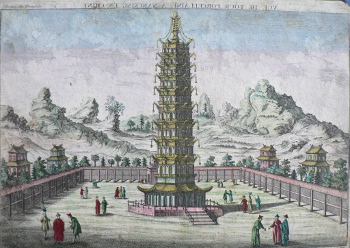(China) Nanking. Engraved by Habermann. Published in France and Germany circa 1750. $750.00

“Vue de Tour Porcellaine a Nancking en Chine”
The octagonal Porcelain Tower also known as Bao’ensi (meaning Temple of Repaid Gratitude) was a pagoda constructed during the 15th century in the Ming Dynasty built of white porcelain bricks that were said to reflect the run’s rays during the day and with 140 lamps that were hung from the building to illuminate it at night. The structure was topped by a golden pineapple. According to the 2014 New York Botanical Gardens book Flora Illustrata reproduces this view and describes the garden with its "irregular layout and exotic decoration of which greatly influenced the development of landscape gardening in Europe."
Vues d’optique (optical views) were created in Europe in the 18th century. They are highly colored engravings of cities that were shown through a viewing device (sometimes called a magic lantern) fitted with a mirror and a convex lens. The titles were printed on the sheets in reverse so that they would appear right side up when viewed. They were drawn with a one point linear perspective which when viewed through the machine created convincingly three dimensionality. Many of these machines were moved from place to place so that the owners could charge fees for public showings of the far flung places depicted. Since the engravings were not bound and very pulled in and out of the viewing machines, they usually show signs of wear.
Nankin, or Nanjing or Nanjing.
Is the capital of Jiangsu province in eastern China and was the capital of the country at several points in history. Located on the lower Yangtze River.
Some vues d’optique such as this one had windows and doors in the buildings cut out and the openings backed with translucent paper so that when the print was backlit, the scenes provided illuminated night views.
16 1/2 x 11 3/4 inches, sheet.
Engraving with original hand coloring.
Trimmed to plate mark.
or click to inquire about this print.
